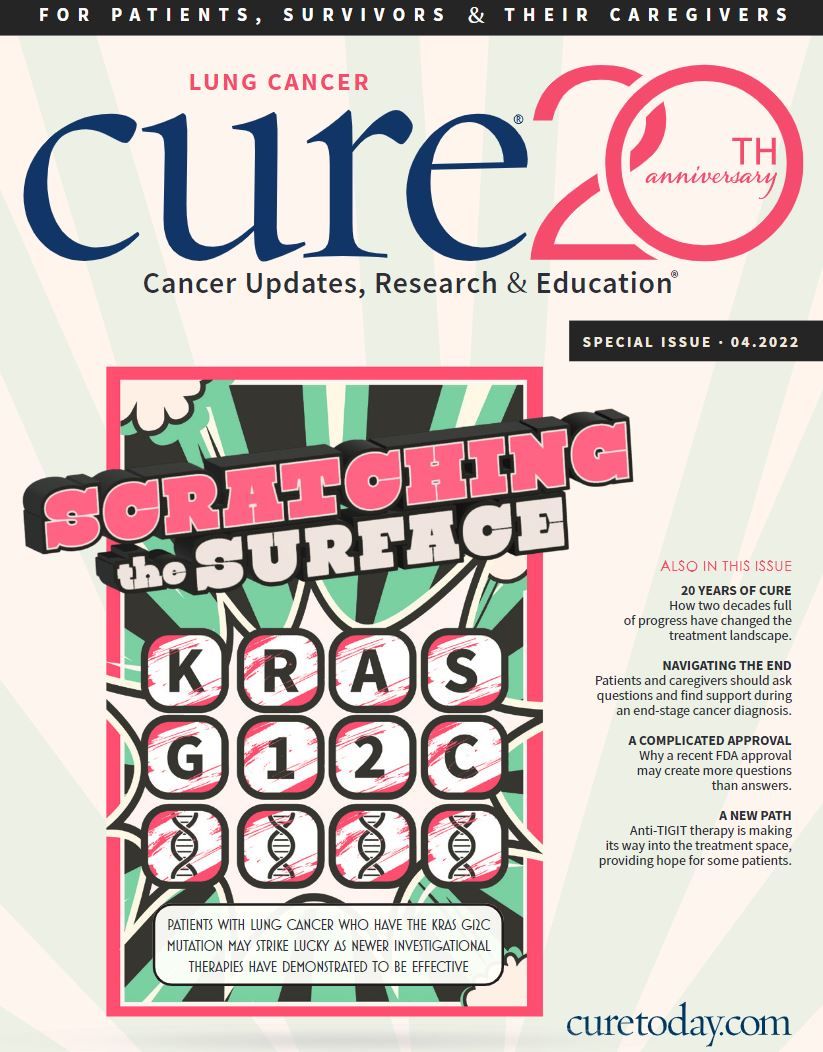Publication
Article
CURE
A New Path Emerges in Lung Cancer Treatment
Author(s):
Anti-TIGIT immunotherapy drugs may improve quality of life and survival, while being well tolerated by patients.
Byron Warner, 82, remembers when he knew the experimental immunotherapy drug combination he had been taking to combat non-small cell lung cancer (NSCLC) was working.
“I go for walks every day and for a long time, breathing was just agony,” he says. “I’d walk to the end of my block and back and it felt like wind sprints in football. But one morning, I went out to walk and I could breathe. It was the most encouraging thing I’ve felt all along.”
The Nashville, Tennessee, resident says he is once again jogging up a hill he struggled to climb before treatment. “I’m really happy,” Warner says.
This is the hope that new immunotherapy drugs targeting an immune checkpoint inhibitor known as TIGIT are bringing to people with lung cancer. TIGIT, short for T cell immunoreceptor with immunoglobulin and ITIM domain, is a new target for immunotherapy drugs that treat cancer that is hoped to build further on the successes seen with standard immunotherapy.
Byron Warner had his wife, Cindy , by his side while being treated with a new therapy in lung cancer.
Photo: LARRY MCCORMACK

Therapies that improve quality of life and survival for patients — and that are well tolerated — are the “holy grail,” according to Dr. Jeffrey Clarke, a medical oncologist at Duke Cancer Institute in Durham, North Carolina. “That’s always what we’re looking for and striving for to grow our armamentarium,” he says.
Anti-TIGIT therapies may offer that promise for people with lung cancer
in that their mechanisms of action are distinct from that of approved “check- point inhibitor” treatments. Although no anti-TIGIT immunotherapy drug has been approved by the Food and Drug Administration (FDA) at this time, clinicians are encouraged by early data from clinical trials.
“It could be even better in some ways than some of the drugs we have,” Clarke says.
Immunotherapy Treatment in Lung Cancer
Immunotherapies are drugs that work to help the immune system destroy cancer. Each day, immune cells (T cells) sweep the body to search for and mitigate bacteria, viruses and cells that should not be there. To protect, the immune system includes built-in stop signs that keep T cells from going too far and destroying healthy cells.
The body creates these stop signs when T cells recognize and bind with certain proteins designed to halt their work. These stop signs are called immune checkpoints. But cancer cells are wily in the way they evolve. They take advantage of these checkpoints to escape notice. When cancer cells can get around immune checkpoints, tumors grow unchecked.
Immunotherapy drugs work by shutting off immune checkpoints to make it easier for T cells to identify cancer. Each of these drugs — known as immune checkpoint inhibitors — works on a specific type of immune checkpoint (sometimes called a pathway).
Immune checkpoints that have FDA-approved therapies for treating lung cancer include CTLA-4, PD-1 and a protein related to PD-1 (PD-L1). Approved immune checkpoint inhibitors include the PD-1 inhibitors Opdivo (nivolumab), Keytruda (pembrolizumab) and Libtayo (cemiplimab) for some people with NSCLC, as well as the PD-L1 inhibitor Tecentriq (atezolizumab). The CTLA-4 inhibitor Yervoy (ipilimumab) is also used to treat some lung cancers.
Byron Warner didn’t want to die and leave his wife, so he had no hesitations starting an anti- TIGIT therapy.

Like targeted therapies (drugs targeting cancer cells that have a specific gene mutation), immunotherapies are known as personalized medicine. Dr. Wallace Akerley, a lung cancer oncologist at the Huntsman Cancer Institute at the University of Utah in Salt Lake City, has been studying lung cancer for
30 years and says personalized medicine has changed how clinicians treat lung cancers.
“Now, when we see a patient, we do a panel of biomarkers to define what the cancer’s weaknesses might be,” he says, adding that his clinic looks for gene mutations that can be treated with eight different gene-specific drugs (targeted therapies).
The clinic also does an immune panel that looks for PD-L1 expression. The findings, Akerley notes, determine which of three therapies individually or in combination — chemotherapy, targeted therapy or immunotherapy — will be used to treat a patient’s specific lung cancer.
Those with genetic mutations start on targeted therapy, whereas patients with high PD-1 or PD-L1 expression get immunotherapy.
“If you have neither of those, you would be getting a chemoimmunotherapy or even dual immunotherapy,“ he says, adding that immune therapies work so well with chemotherapy that most people no longer have chemotherapy alone.
TIGIT: A New Pathway in Lung Cancer Immunotherapy
TIGIT is a more recently identified immune checkpoint that is now being targeted with various therapies in clinical trials. Researchers have been studying patient response to anti-TIGIT therapy as a monotherapy (the only treatment given) and in combination with other immunotherapy drugs.
“The TIGIT drug has been looked at individually and there’s been some activity seen,” Akerley explains. “It’s also been used in conjunction with PD-1 inhibition so two checkpoint blockades. There is preliminary data that this is much more effective.”
Warner took part in a clinical trial of an anti-TIGIT drug in combination with another immunotherapy. After being diagnosed with NSCLC — specifically, a 7-centimeter inoperable tumor in his upper left lung — he had six weeks of radiation (five treatments per week) combined with weekly chemotherapy.
When he finished this grueling course of treatment, his oncologist, Dr. Melissa Johnson, director of the Lung Cancer Research program at Sarah Cannon Research Institute in Nashville and a medical oncologist with Tennessee Oncology, recommended that Warner enter a study assessing the anti-TIGIT immunotherapy tiragolumab in combination with Tecentriq.
Of note, the drug combination was granted a breakthrough therapy designation by the FDA in early 2021 based on data from the phase 2 CITYSCAPE trial.
Warner was enrolled in the phase 3 SKYSCRAPER-03 which is investigating the safety and efficacy of tiragolumab in combination with the FDA-approved PD-L1 inhibitor Tecentriq against Imfinzi (durvalumab) — an anti-PD-L1 therapy — in people with inoperable stage 3 NSCLC who had been previously treated with a combination of chemotherapy and radiation.
For just over a year, Warner had a monthly infusion of the combined immunotherapies. The results of the trial are not available to the public yet.
There are several anti-TIGIT therapies being studied in clinical trials. Among the drugs being studied in lung cancer treatment are tiragolumab, ociperlimab, vibostolimab and a TIGIT inhibitor known as BMS-986207.
“Treatment of lung cancer has transformed with the introduction of immunotherapy, with significant improvements in survival,” adds Dr. Jessica Bauman, a thoracic oncologist and chief of the Division of Head and Neck Medical Oncology at Fox Chase Cancer Center in Philadelphia.
“TIGIT is an intriguing type of novel immunotherapy. When it is blocked, it may enhance the immune system and improve the responses to current immunotherapies. From the early clinical studies, it does look to be most effective in combination with PD-1 or PD-L1 blockade as well.”
Clarke says the data he has seen from anti-TIGIT drug clinical trials in patients with high expression of PD-L1 are the most exciting.
“Patients who have the highest expression of PD-L1 seem to have the most benefit,” he explains. “This could help guide us decide who should get this type of treatment versus another type of treatment. I think we need to have more data to tell us for sure who’s going to benefit from this treatment versus who wouldn’t.”
The Side Effects Question
For many people with lung cancer, questions about potential side effects from cancer treatment loom large. Immunotherapy side effects include inflammation, which could involve any organ in the body, according to Clarke.
“Rash is very common, as is colitis causing diarrhea,” he says.
In treating cancers with immunotherapy, clinicians want the immune system to be activated to find the cancer and kill it but do not want the immune system to be activated against healthy tissue, Bauman says. That creates a need for a delicate balance when using these drugs.
“We see the immune system causing pneumonitis, hepatitis, colitis, myocarditis, thyroiditis, as well as others,” she says. “Those immune-related toxicities are often treatable with high-dose steroids and patients do well. One of the concerns about using multiple avenues to activate the immune system is that you increase the risk of immune toxicities.”
But early data from studies of immunotherapy combinations that include anti-TIGIT drugs are not showing a significant increase in toxicities, according to Bauman.
“Immune toxicities look similar to what is already known from the PD-1 therapies, which have a lower rate of toxicities than some of the other checkpoints that have been studied in trials,” she adds.
Warner notes that treatment is strenuous for people with cancer. “Radiation and chemo together just really sap your strength and your mental energy as well,” he says. “When I went to immunotherapy, I noticed that I was feeling down and a little bit listless for three or four days afterward, but then I came back stronger.”
Warner says he did not experience any rash or gastrointestinal symptoms.
The Potential of Anti-TIGIT Treatments
Concerns about balancing the benefits of immunotherapy combinations against potential toxicities for people with lung cancer may contribute to the length of the approval process for these drugs.
“Over the last decade, there has been so much research into immunotherapies and immunotherapy combinations,” Bauman says. “We’ve had amazing progress on one hand and yet we still have had relatively slow progress.”
But the personalization of lung cancer treatment — including anti-TIGIT therapies now in development — offers significant hope to many people with lung cancer. Clinical trials that include tissue and blood biomarker analysis play a critical role in advancing the state of this science by understanding both the drug impact as well as underlying biology.
“Many patients are certainly open to clinical trials,” Bauman adds. “It depends on the underlying science, where they live, how often they have to come in and the potential risks and benefits.”
Johnson says the mission of every clinical trial is to provide patients, like Warner, with potentially life-changing therapies.
“We believe clinical trials should be first, not last, because good outcomes are possible,” she says. “He had the unresectable stage 3 lung cancer the trial was looking for, and he really had a sincere desire to make sure we did everything we could to get rid of the cancer. That’s a perfect patient to talk to about clinical trials.”
Warner says he did not have any reservations about taking part in the anti-TIGIT therapy trial. “I thought, ‘I can take the side effects,’ ” he says. “What I don’t want to do is pass away from cancer. My wife, Cindy, was always with me. She’s been doing the heavy lifting for about 18 months now.”
Clarke notes that in many ways, the lung cancer community is seeing strides in treatment that it has not seen in decades past. “It’s very exciting, but we still have a long way to go,” he says of anti-TIGIT therapies. “I think we’re all looking forward to the results of these clinical trials.”
*EDITOR’S NOTE: Following the submission of this feature, the drug maker, Genentech, announced that the SKYSCRAPER-02 trial, which combined Tecentriq and tiragolumab in patients with small cell lung cancer, failed to reduce the rate of disease progression and death when compared with Tecentriq and chemotherapy only.
*EDITOR’S NOTE: SKYSCRAPER-03 is an open-label trial that is an ongoing study. Data from the study has not yet readout.
For more news on cancer updates, research and education, don’t forget to subscribe to CURE®’s newsletters here.
Tell us about someone making a significant positive impact in the lives of patients with lung cancer.Nominations for the 2022 Lung Cancer Heroes is open now through May 15! To submit, click here.





